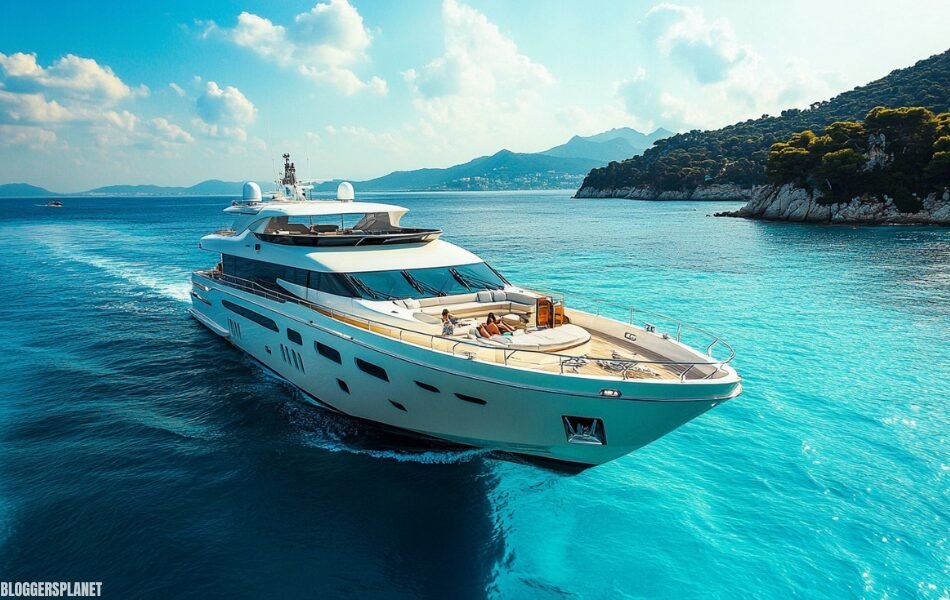$8 Million Yacht Capsizes Near Annapolis in Tragic Accident

A stunning 8 million dollar yacht met a tragic end as it capsized near the serene waters of Annapolis. On July 27, 2024, at approximately 12:30 PM, the 122-foot luxury yacht, Lovebug, experienced a catastrophic event that sent shockwaves through the local maritime community. This incident raises questions about the circumstances surrounding the capsizing, the potential causes, and the extensive rescue efforts undertaken by local authorities.
This article delves into the intricate details of the event, exploring the potential factors that may have contributed to the $8 Million Yacht Capsizes Near Annapolis demise. It also examines the swift response of emergency services and the challenges faced during the rescue operation.
A Tragic Turn of Events
The 122-foot luxury yacht, Lovebug, met a catastrophic end on July 27, 2024, near Annapolis, Maryland. At approximately 12:30 PM, the vessel, valued at $8 million, began taking on water and rapidly capsized.
Eyewitness accounts describe a harrowing scene as the yacht dramatically tilted to one side before submerging. The suddenness of the incident left those on board scrambling for safety. Fortunately, all five individuals were rescued by Good Samaritans and local authorities.
The Coast Guard and Maryland Natural Resources Police swiftly responded to the distress call. The rescue operation involved multiple agencies working together to ensure the safety of those on board and to mitigate any potential environmental impact.
Unraveling the Mystery: Potential Causes of the Capsizing
While the specific weather conditions at the exact moment of the capsizing are still under investigation, local meteorological data indicates that the Annapolis area experienced moderate winds and choppy waters on the day of the incident. However, it’s crucial to note that even under relatively benign conditions, a sudden shift in weather, such as a squall or a rogue wave, could destabilize a vessel.
The Lovebug, a 122-foot luxury yacht, was relatively young and had undergone regular maintenance. However, maritime experts suggest that even well-maintained vessels can suffer from unforeseen mechanical failures. A thorough investigation into the yacht’s maintenance records, engine logs, and hull integrity will be essential to determine if any mechanical issues contributed to the capsizing.
The crew members aboard the Lovebug were experienced mariners. However, even seasoned professionals can face challenges in adverse conditions. Human error, such as misjudgment or delayed response to a developing situation, cannot be entirely ruled out.
While the exact sequence of events leading to the capsizing is still unclear, human error remains a potential factor. Overloading the vessel, improper weight distribution, or negligence in following safety protocols could have contributed to the tragedy. Additionally, a sudden influx of water, perhaps due to a breach in the hull or a malfunctioning bilge pump, could have overwhelmed the crew’s ability to respond effectively.
A Race Against Time: The Rescue Operation
As news of the capsizing reached local authorities, a swift and coordinated response was initiated. The U.S. Coast Guard, Maryland Natural Resources Police, and Anne Arundel County Fire Department were among the first responders to arrive at the scene. The urgency of the situation demanded immediate action, as the capsized yacht posed a significant threat to the lives of those on board and the environment.
The rescue operation was a complex endeavor that required the expertise of trained professionals. Rescue teams, equipped with specialized equipment and watercraft, worked tirelessly to locate and extract individuals from the water. The use of helicopters proved invaluable in surveying the area and aiding in the rescue efforts.
Divers were deployed to search the submerged vessel for any remaining occupants. The challenging underwater conditions, including low visibility and strong currents, made the search and recovery operation particularly difficult.
Fortunately, all five individuals aboard the Lovebug were rescued safely. While the swift response of emergency services undoubtedly saved lives, the incident serves as a stark reminder of the dangers inherent in boating, even for experienced mariners.
Environmental Consequences of the Capsizing
One of the primary concerns following a maritime incident of this magnitude is the potential for fuel spills. Luxury yachts like the Lovebug carry significant amounts of diesel fuel, which can have devastating effects on marine ecosystems. The release of oil into the water can harm marine life, contaminate shorelines, and disrupt delicate ecological balances.
Fortunately, in this case, swift action by response teams helped to mitigate the risk of a major fuel spill. Containment booms were deployed to surround the capsized vessel, preventing the spread of any leaked fuel. Skimmer boats were also utilized to remove any oil from the water’s surface.
The capsizing of the Lovebug resulted in substantial debris, including large sections of the vessel, scattered across the water. The removal of this debris is a complex and time-consuming process. Divers and specialized salvage teams must work carefully to recover the wreckage without causing further damage to the marine environment.
The salvage operation is not only a technical challenge but also an environmental one. It is essential to minimize disturbance to the seabed and avoid releasing additional pollutants into the water. As the cleanup efforts continue, it is hoped that the environmental impact of the capsizing can be minimized.
Insurance and Legal Ramifications
The capsizing of an $8 million yacht inevitably raises questions about insurance coverage. Yacht owners typically carry a variety of insurance policies to protect their investment. These policies may include hull insurance, liability insurance, and loss of use coverage.
Hull insurance covers damage to the yacht itself, including structural damage, mechanical breakdowns, and, in some cases, total loss. Liability insurance protects the owner from claims made by third parties for property damage or personal injury. Loss of use coverage compensates the owner for financial losses incurred due to the yacht being unavailable for use.
The extent of insurance coverage for the Lovebug will depend on the specific terms of the policy. Factors such as the cause of the capsizing, the level of coverage, and any exclusions or limitations in the policy will influence the amount of compensation the owner may receive.
The capsizing of the Lovebug may lead to legal proceedings, including investigations by maritime authorities and potential lawsuits. Maritime law governs accidents and incidents involving vessels, and it is likely that various legal principles will be applied to determine liability and damages.
Investigators will examine factors such as the crew’s actions, the vessel’s maintenance history, and prevailing weather conditions to determine the cause of the capsizing. If negligence or other wrongdoing is found, individuals or organizations may be held liable.
Civil lawsuits may be filed by the yacht owner to recover losses, and personal injury claims may be brought by individuals who were injured in the incident. The legal proceedings surrounding the capsizing of the Lovebug could be complex and protracted, involving maritime lawyers, insurance adjusters, and expert witnesses.
Conclusion
The capsizing of the $8 Million Yacht Capsizes Near Annapolis serves as a powerful reminder of the importance of maritime safety. While luxury yachts offer comfort and style, they are not immune to the challenges of the open sea. This incident underscores the need for thorough maintenance, weather awareness, and safety preparedness while boating.
Our thoughts are with those who were affected by this unfortunate event. While no fatalities occurred, this tragedy highlights the inherent risks involved in luxury boating. It is crucial to stay informed about safety protocols and to take every possible precaution to ensure safe voyages on the water.
We invite you to share your thoughts or experiences regarding this incident. Have you ever encountered an unexpected maritime challenge? Your perspective can help others understand the importance of preparedness and safety while boating.
FAQ’s
Q: What happened to the $8 Million Yacht Capsizes Near Annapolis?
A: The 122-foot luxury yacht, Lovebug, capsized near Annapolis, Maryland on July 27, 2024. All five people on board were rescued.
Q: What are the potential causes of the capsizing?
A: Several factors may have contributed to the capsizing, including adverse weather conditions, mechanical failures, human error, or a combination of these. A thorough investigation is underway to determine the exact cause.
Q: How was the rescue operation conducted?
A: Local authorities, including the Coast Guard and Maryland Natural Resources Police, responded swiftly to the incident. Rescue teams used boats and helicopters to locate and evacuate the individuals on board. Divers also searched the submerged vessel for any remaining occupants.
Q: What is the environmental impact of the capsizing?
A: The capsizing of a large yacht can have significant environmental consequences, particularly if there is a fuel spill. However, in this case, swift action by response teams helped to contain any potential fuel leaks. The removal of debris from the water is also a major concern, as it can harm marine life and disrupt the ecosystem.








